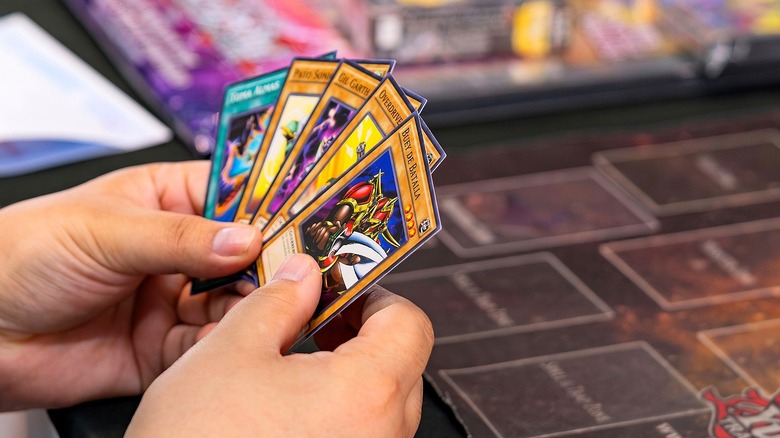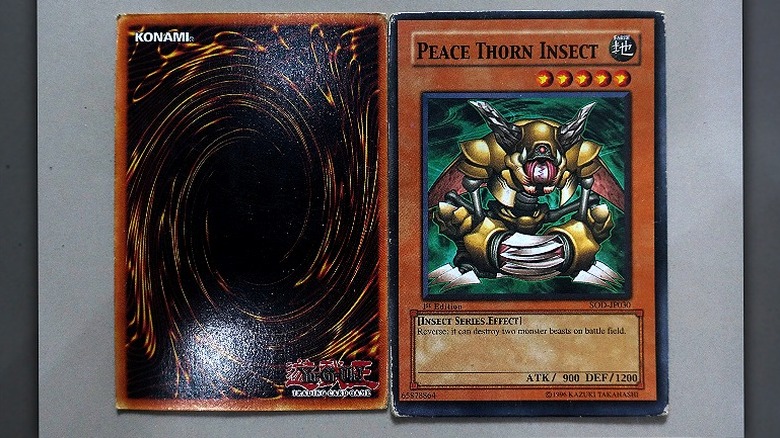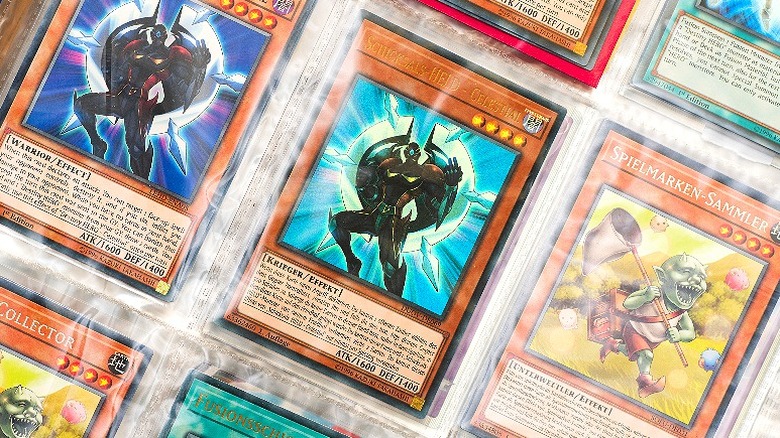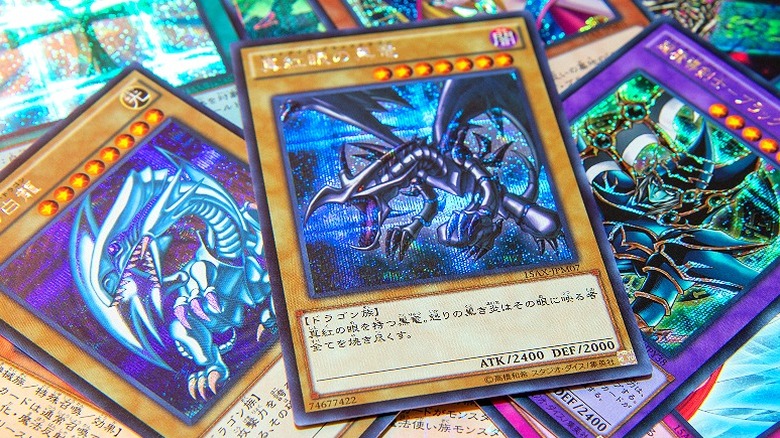How To Tell If Your Old Yu-Gi-Oh! Cards Are Worth Any Money
If you were born in the 1990s or early 2000s, there's a good chance that somewhere in your childhood home you have a few decks of Yu-Gi-Oh! cards tucked away somewhere. The good news is that, although they may have been collecting dust since you last used them, these childhood favorites also may have been accumulating in value.
For those unfamiliar with the name, "Yu-Gi-Oh!" is a Japanese manga series dating back to late 1996. It centers around the card game "Duel Monsters," where opposing players duel each other by unleashing different cards that summon fantasy monsters into battle. Two years after it debuted, "Yu-Gi-Oh!" was adapted into a TV anime, and then into an actual real-world card game titled, simply enough, Yu-Gi-Oh! Trading Card Game, which gained mass popularity upon its release in the U.S. and Europe in 2002. By 2009, the Guinness Book of World Records had named Yu-Gi-Oh! the top-selling trading card game in the world.
Which brings us back to today and your own old Yu-Gi-Oh! trading cards. Here's how to tell if any of them have gained in value.
Check the card's condition
The first metric in determining the value of Yu-Gi-Oh! cards is condition, so you may want to wipe off all that dust carefully. Condition is ranked by the Professional Sports Authenticator (PSA), the industry standard for the authentication and grading of trading cards. PSA has 11 categories overall, ranging from Gem Mint (PSA 10) to Poor (PSA 1). The point scale is as follows: PSA 10 is a Gem Mint; PSA 9 is a Mint; PSA 8 is a Near-Mint Mint; PSA 7 is Near Mint; PSA 6 is Excellent-Mint; PSA 5 is Excellent; PSA 4 is Very Good-Excellent; PSA 3 is Very Good; PSA 2 is Good; PSA 1.5 is Fair; and PSA 1 is Poor.
To be considered a Gem Mint (10), a card obviously must be in flawless perfect condition, while a Mint (9) score is given to cards that are essentially perfect but with very specific, minor flaws, like a slight wax stain. High-end cards that appear brand new, as if they were just pulled from a pack, but have minor visible flaws, such as a scratch or signs of aging, will fall into the Near-Near Mint (8) to Excellent (5) range.
Cards that receive PSA ratings of 4 through 2, meanwhile, will show signs of more visible wear and tear from use, yet are otherwise indistinguishable from the previous four categories when sleeved (i.e., put in a plastic sleeve for protection). Finally, if your (Yu-Gi-Oh!) cards are deemed Fair (1.5) or Poor (1), then it's because they show significant damage, such as a tear. (See what an old Lite-Brite might be worth today, or the unexpected value of your old Barbies.)
Determine the card's rarity
Along with condition, you can use rarity to ascertain the value of different Yu-Gi-Oh! cards. Certain Yu-Gi-Oh! cards have been produced in limited numbers, making them more inherently valuable than others. For this reason, each individual rare card is ranked on a scale to determine which has the highest rarity.
Generally speaking, there are 10 different categories of rarity for Yu-Gi-Oh! cards, each of which have different levels of ascending value. The top-level categories are Common, Rare, Super Rare, Ultra Rare, and Ultimate Rare. Common Yu-Gi-Oh! cards are of the least value, and they have no holographic filament or shiny lettering. This is pretty much just your standard Yu-Gi-Oh! card. Rare cards, meanwhile, can be determined by shiny silver or black lettering on the title of the cards. As for Super Rare, Ultra Rare, and Ultimate Rare cards, they feature a holographic filament that covers the entire card, producing a shiny rainbow-colored glare when tilted from side to side.
The most valuable of all rare Yu-Gi-Oh! cards include the subcategories of Secret Rare, Ghost Rare, Starfoil Rare, Starlight Rare, and Gold Rare. Secret Rare and Ghost Rare cards possess a shiny silver holographic foil on the surface, while Starfoil cards have shiny holographic stars on them. Starlight Rare Yu-Gi-Oh! cards can be described as possessing a holographic foil that shines like a million little stars, while Gold Rare cards shimmer in a holographic gold. Suffice to say, these examples of Yu-Gi-Oh! cards are much harder to come across, so if you find any of them in your childhood deck, you can be sure you've hit the jackpot.
Other factors to consider
Outside of condition and rarity, there are a few other factors that can make certain Yu-Gi-Oh! cards more valuable. Notably, the edition of the card (meaning what year it was released) can drive up its value substantially. As with any collectible, from books to coins to albums or stamps, first-edition Yu-Gi-Oh! cards obviously hold a lot of value for collectors due to them being some of the earliest cards ever released.
Yu-Gi-Oh! cards that have historically dominated or been won in real-life tournaments also hold substantial value. For example, the Blue Eyes White Dragon (T3-01), an Ultra Rare card signed by "Yu-Gi-Oh!" author Kazuki Takahashi, was gifted to the Asia Championship 2001 winner, and is today worth ~$400,000.
So, in summary, if you're visiting your parents' house this holiday season and find some old decks of Yu-Gi-Oh! cards from your youth, check them out for their potential worth. One of the quickest ways to do so is to use a Yu-Gi-Oh! card scanning app, like Card Scanner for YuGiOh or YGO Scanner – Dragon Shield. If you're lucky, you may just have one that's turned into a collectible with time. (Check out five Pokémon cards that are worth a ton of money today.)



